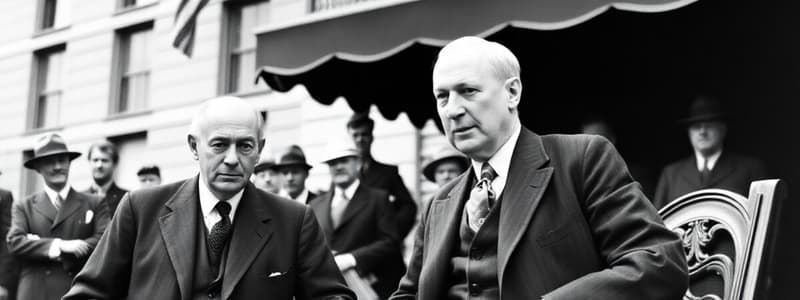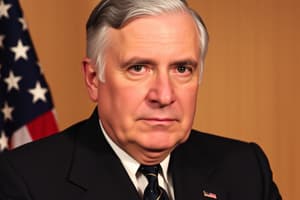Podcast
Questions and Answers
Which of the following factors contributed to the business boom in the 1920s?
Which of the following factors contributed to the business boom in the 1920s?
- Laissez-faire attitude of the government (correct)
- Increased government regulation
- Decreased productivity
- Reduced use of oil and electricity
The Kellogg-Briand Pact of 1928 successfully outlawed all forms of war.
The Kellogg-Briand Pact of 1928 successfully outlawed all forms of war.
False (B)
What was the primary topic discussed at the Washington Naval Conference during the Harding presidency?
What was the primary topic discussed at the Washington Naval Conference during the Harding presidency?
disarmament
President Harding's campaign slogan was a "return to ______".
President Harding's campaign slogan was a "return to ______".
Match the following individuals with their roles or involvements during the Harding presidency:
Match the following individuals with their roles or involvements during the Harding presidency:
What was a key provision of the Five-Power Treaty signed after the Washington Naval Conference?
What was a key provision of the Five-Power Treaty signed after the Washington Naval Conference?
The Fordney-McCumber Tariff of 1922 decreased taxes on foreign goods entering the United States.
The Fordney-McCumber Tariff of 1922 decreased taxes on foreign goods entering the United States.
What was the main objective of the Dawes Plan of 1924?
What was the main objective of the Dawes Plan of 1924?
The National Origins Act of 1924 limited immigration visas to 2% of the total number of people of each nationality in the U.S. as of the ______ census.
The National Origins Act of 1924 limited immigration visas to 2% of the total number of people of each nationality in the U.S. as of the ______ census.
Which of the following best describes the 'business doctrine' embraced by President Coolidge?
Which of the following best describes the 'business doctrine' embraced by President Coolidge?
Flashcards
Business Doctrine
Business Doctrine
The prevailing view among Republicans that favored business leadership in driving economic development during the 1920s.
1920s Economic Boom
1920s Economic Boom
A period in the 1920s characterized by increased productivity, use of oil and electricity, and a laissez-faire governmental approach.
Return to Normalcy
Return to Normalcy
Campaign promise of Warren G. Harding, reflecting a desire to return to pre-WWI conditions.
Teapot Dome Scandal
Teapot Dome Scandal
Signup and view all the flashcards
Limited Government
Limited Government
Signup and view all the flashcards
Washington Naval Conference
Washington Naval Conference
Signup and view all the flashcards
Five-Power Treaty
Five-Power Treaty
Signup and view all the flashcards
Fordney-McCumber Tariff
Fordney-McCumber Tariff
Signup and view all the flashcards
National Origins Act of 1924
National Origins Act of 1924
Signup and view all the flashcards
Dawes Plan of 1924
Dawes Plan of 1924
Signup and view all the flashcards
Study Notes
The 1920s: Politics
- Republicans held control during the 1920s with three presidents: William Harding, Calvin Coolidge, and Herbert Hoover.
- The Republican party dominated Congress, believing the economy would grow if business led the way.
- The 1920s saw a business boom from increased productivity, oil/electricity use, and a laissez-faire government approach.
- Economic growth led to low unemployment (below 4%), improved living standards, more indoor plumbing/central heating, and higher incomes for middle/working classes.
The Harding Presidency (1921-1923)
- Harding campaigned on a "return to normalcy".
- His presidency was marked by scandals.
- The Teapot Dome scandal involved Secretary of Interior Albert Fall accepting bribes for oil leases near Teapot Dome, Wyoming.
- Attorney General Harry Daugherty took bribes to avoid prosecuting criminals.
- Harding died of a heart attack in August 1923 before the scandals were exposed.
The Coolidge Presidency (1923-1928)
- Coolidge believed in limited government and embraced the business doctrine.
- Coolidge is quoted as saying, "The chief business of the American people is business."
Foreign Policy: Washington Naval Conference
- The Washington Naval Conference is considered the greatest achievement of the Harding presidency.
- Hosted by Secretary of State Charles Evans Hughes, the topic was disarmament.
- Nations in attendance: Belgium, China, France, Great Britain, Italy, Japan, the Netherlands, and Portugal.
- Resulted in the signing of several treaties:
- Five-Power Treaty: the U.S., Great Britain, France, Japan, & Italy agreed to maintain current naval tonnage and stop building new ships for 10 years
- Britain and the U.S. agreed not to fortify Pacific possessions and to respect each other's territory.
- Nine Power Treaty: All nations agreed to respect the open-door policy in China.
Foreign Policy: Fordney-McCumber Tariff (1922)
- Increased taxes on foreign goods by 25%.
- Foreign nations retaliated with tariffs on U.S. goods.
Foreign Policy: National Origins Act of 1924
- Over one million immigrants, mainly Catholics and Jews from eastern and southern Europe, entered the country between 1919 and 1921.
- This influx fueled the Red Scare of 1919 and increased nativism.
- The Act limited immigration by setting quotas based on nationality.
- Immigration visas were limited to 2% of the total number of people of each nationality in the U.S. as of the 1890 census.
Foreign Policy: Dawes Plan of 1924
- Addressed war debts and reparations issues after World War I.
- The U.S. expected European allies to repay $10 billion in loans.
- Allies claimed they were unable to pay.
- U.S. banks/businesses were encouraged to lend/invest in Germany, so Germany could rebuild, pay reparations to Allies, who could then repay the U.S.
- The plan ultimately failed; only Finland fully repaid the U.S.
Foreign Policy: Kellogg-Briand Pact (Pact of Paris of 1928)
- Negotiated between the U.S. and France.
- Renounced the aggressive use of force to achieve national ends.
- It was an attempt to outlaw offensive wars.
- Eventually, 62 nations signed the pact.
- It ultimately failed because it didn't outlaw defensive wars, nor did it provide actions against violators.
Foreign Policy: Dollar Diplomacy
- U.S. used diplomacy to advance American business interests in Latin America and the Middle East.
Studying That Suits You
Use AI to generate personalized quizzes and flashcards to suit your learning preferences.




